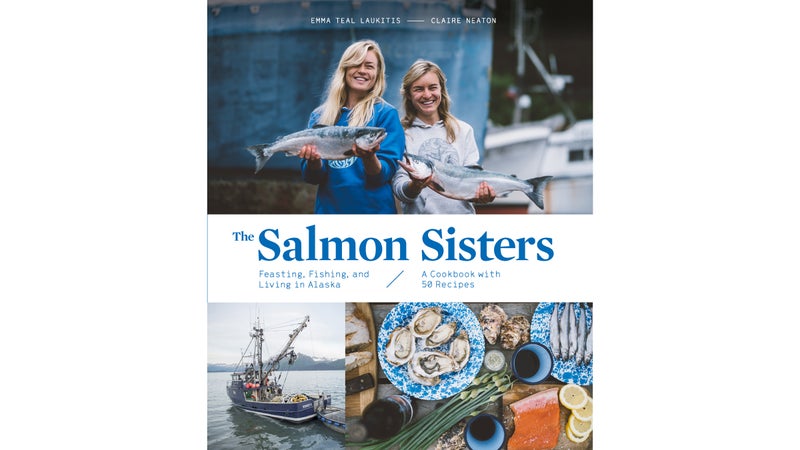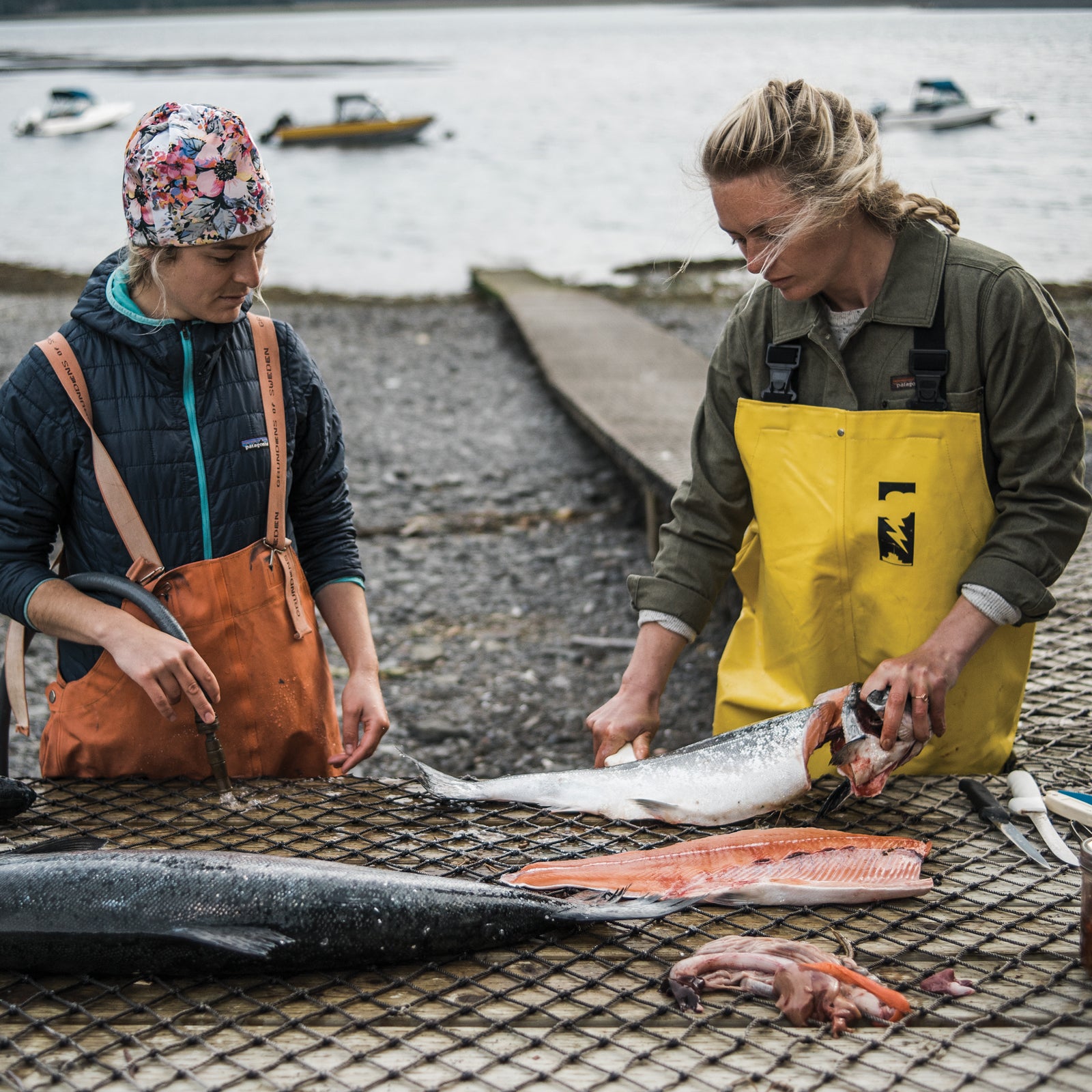Sisters Emma Teal Laukitis and Claire Neaton learned to fillet a fish before they fit into their , harvesting salmon aboard their family’s commercial boat in Alaska’s remote Aleutian Islands. Now they’re champions of the region’s fishing industry and have become the state’s most beloved influencer duo. They campaign for responsible fisheries management and fight to preserve Alaska’s working waterfront culture. In 2012, they launched a successful brand that sells sustainably caught fish as well as a trendy clothing line. As their business grew, however, the sisters started noticing that many of their customers weren’t very confident cooking seafood. “We realized that once we get fish into people’s hands, a lot of folks are still uneasy about preparing seafood, largely because they don’t want to mess up such a beautiful product,” says Neaton.
The siblings’ latest endeavor aims to address this problem: a cookbook called . It’s a collection of 50 recipes from their childhood dinner table. The dishes are curated by their mother and use ingredients abundant in most Alaskan communities—straight-from-the-sea fish, vegetables from personal gardens, and wild plants and berries—but easy to purchase anywhere. “Once people get used to cooking seafood at home, they realize how simple and easy it can be,” says Laukitis. “It’s really difficult to mess it up as long as you don’t overcook it. Right now, with people working and spending more time at home, so many folks have expressed their excitement to learn about cooking fish.”
The average American has a relatively small appetite for seafood, consuming just 14.9 pounds of it in 2018 compared to 55.4 pounds of beef and 90.1 pounds of poultry, according to the USDA. While market research shows that , it has also found that many of us don’t feel equipped to identify ethically sourced products, nor do we know how to prepare them properly. Sockeye salmon fillets seem easy to overcook and char beyond saving, steaming an enormous Dungeness crab is quite a task for dinner, and who even knows what a geoduck is, let alone how to cook it (for the record, it’s a species of large, odd-looking clam, and it’s pronounced “gooey duck.”) Further, the market research found that when consumers do make an attempt, they pick the cheapest seafood option so it isn’t a waste when they mess it up.

The Salmon Sisters’ cookbook aims to be an entry point for anyone looking to add more seafood to their diet and support the nation’s small-scale fishermen in the process. They start from square one: how to source it. Laukitis and Neaton recommend keeping an eye out for wild-caught American fish in your grocery store and looking for labels from either the ���ǰ� to ensure it was sustainably caught. Local Catch’s is a great way to purchase directly from fishermen in your area. And don’t be afraid of frozen or tinned fish if you live far from a coast, or, say, are in quarantine for the foreseeable future. “We love tinned smoked salmon, sardines, tuna, oysters and octopus,” says Laukitis. “It is shelf-stable, which means you can take it on adventures, camping trips, bring it to work with you, and it doesn’t need to be refrigerated until it’s opened.”
Neaton adds: “Sure, there’s nothing like fresh fish straight from the fishing boat, but frozen fish is processed and frozen quickly after it is harvested to maintain quality and freshness. It also keeps in your freezer for up to nine months, so you can enjoy it at your own pace and have a healthy reserve of protein on hand.” You can order Alaskan seafood directly from the Salmon Sisters without leaving your house: they have frozen sockeye salmon, cod, and halibut , as well as a few .
Once you have the ingredients, pick up their new cookbook, which provides context on how U.S. commercial fisheries operate and then explains how to fillet a whole fish properly. Afterward, the book lays out dozens of delicious recipes from easy (a wild-salmon poke bowl) to expert (a massive pot of spicy cioppino—an Italian-American fisherman’s stew). Below are two recipes excerpted from the book that were family staples for the sisters growing up.
Coconut Curry Fish Soup
This Thai-inspired coconut curry soup is comforting like a chowder but also light and alive with fresh lime juice, ginger, and cilantro. We love making it on the boat because the ingredients are simple and readily available, yet the flavor is fresh and tangy. Red curry paste (we used store-bought) brings the broth to life with its red chilies, coriander, lemongrass, garlic, and shallots. This soup is tasty made with salmon, halibut, rockfish, or shrimp—or throw in a combination! You can double the recipe for a big pot that will last you all week, adding fresh garnishes to each bowl you enjoy. When we’re fishing in Prince William Sound during the summer, we like to add fresh spot prawns that we’ve caught and serve the soup over steaming white rice for an even heartier meal.
Makes six to eight servings.
Ingredients
- 2 tablespoons coconut oil
- Half a yellow onion, diced
- 3 to 4 cloves garlic, minced
- 1/2 cup red curry paste
- 1 tablespoon light brown sugar
- 2 (14-ounce) cans coconut milk
- 2 1/2 cups fish, vegetable, or chicken stock
- 1/4 cup freshly squeezed lime juice (from about 2 limes)
- 1/4 cup finely chopped fresh ginger
- 2 tablespoons soy sauce
- 2 cups thinly sliced carrots
- 1 1/2 cups chopped green beans
- 2 cups cubed wild skinless salmon, halibut, rockfish, or whole shelled shrimp
- 1/2 cup fresh cilantro leaves, for garnish
- 2 limes, sliced, for garnish
Instructions
Heat the oil in a large saucepan over medium-high heat. Add the onion and sauté until translucent. Add the garlic and sauté until lightly browned. Add the curry paste and cook for one minute, stirring constantly. Add the brown sugar and cook for one minute. Stir in the coconut milk, stock, lime juice, ginger, and soy sauce.
Reduce the heat to low, cover, and simmer for 30 minutes. Add the carrots and cook for five minutes. Add the green beans and cook for five more minutes���ǰ� until the vegetables are crisp-tender. Add the fish and cook for two minutes. Garnish the soup with cilantro and slices of lime.
Superfood Salmon Cakes
Our friend Jan has worked for many years as a commercial-fisheries manager for the Alaska Department of Fish and Game, which is partly to say: she knows fish and she knows how to cook them. Jan’s salmon cakes often fuel the women who play on her ice-hockey team before tournaments and herself on long open-ocean swims, but yours might be the perfect protein-packed weeknight meal. These salmon cakes are our favorite way to give leftover salmon a second life���ǰ� to use the canned salmon in our pantry cupboards. Serve with the spicy dipping sauce for maximum enjoyment.
Makes four to six servings.
Ingredients
- 1 tablespoon extra-virgin olive oil
- 1 medium yellow onion, diced
- 2 (15-ounce) cans wild pink or red salmon, or 4 cups cooked salmon, bones removed
- 1 1/2 cups Italian bread crumbs, plus more for dredging
- 1/2 cup chopped fresh parsley
- 1 teaspoon kosher salt
- 1 teaspoon freshly ground black pepper
- 3 large eggs, beaten
- 1 tablespoon mayonnaise
- 1 tablespoon Dijon mustard
- 1 tablespoon Worcestershire sauce
- Vegetable oil, for frying
��ǰ����ٳ�����پ���辱�Բ��������ܳ���
- 1/2 cup mayonnaise
- 1 tablespoon Tiger Sauce or other favorite hot sauce
Instructions
Heat the olive oil in a large frying pan over medium heat. Sauté the onion until translucent, then transfer to a small plate and set aside to cool. Wipe out the pan to reuse.
In a large bowl, mix together the salmon, bread crumbs, parsley, salt, pepper, and cooled onion. In a small bowl, whisk together the eggs, mayonnaise, mustard, and Worcestershire. Add the dressing to the salmon mixture. Form the mixture into one-third-cup balls and then flatten into burger-shaped patties. Dredge in bread crumbs.
In the large frying pan, heat the vegetable oil. Carefully lower the salmon cakes into the hot oil, frying them until golden brown, about three minutes per side.
Meanwhile, make the spicy dipping sauce by mixing together the mayonnaise and Tiger Sauce in a small bowl. Serve with the salmon cakes.
(c)2020 by Emma Teal Laukitis and Claire Neaton. Excerpted from Salmon Sisters: Feasting, Fishing, and Living in Alaska by permission of Sasquatch Books.


